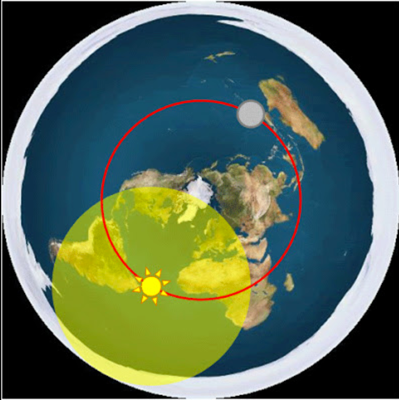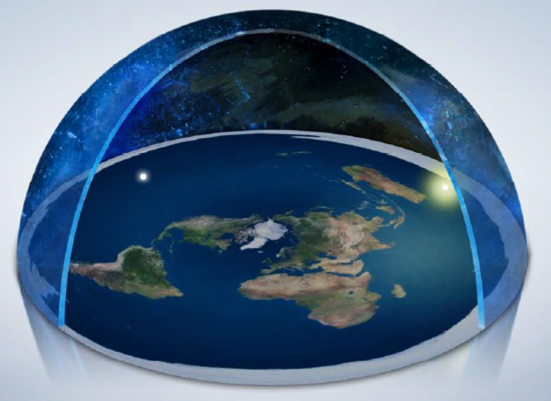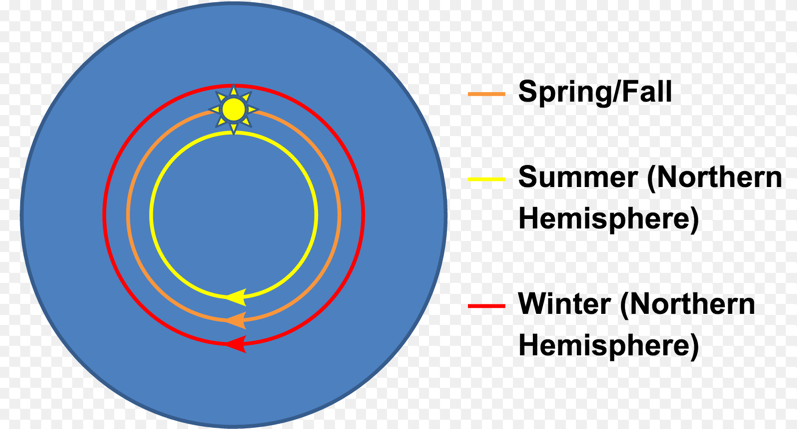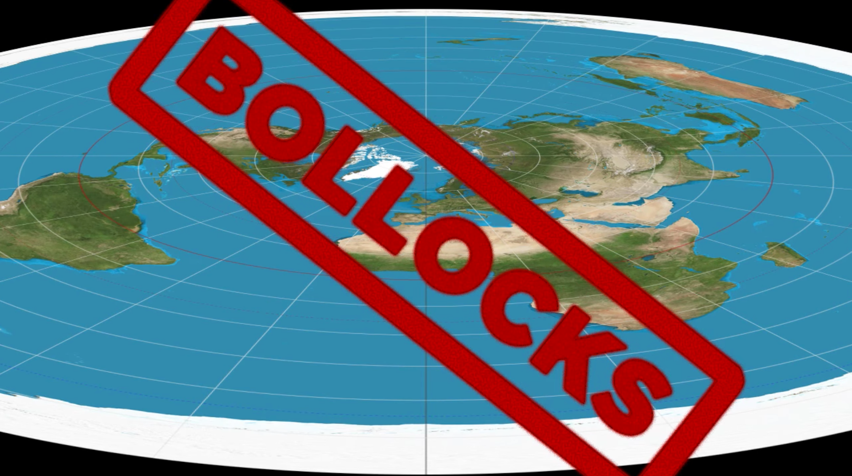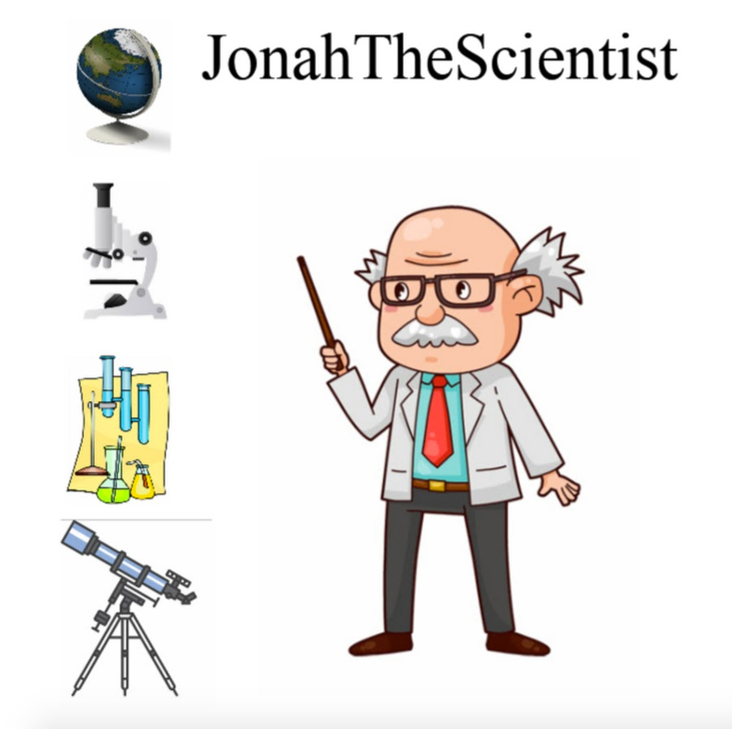Flat Earth NOT - Did mankind ever land on the Moon? Ample evidence to back that up is available even today (September 2020). Let's take a look.
Did we (mankind) ever land on the Moon? Ample evidence to back that up is available even today. Let's take a look.
With regard to proving manned lunar landings after the fact, there are several sources we can look at today – the moon rocks brought back to Earth, current photos of the Apollo landing site, Earth based lasers bouncing their beam off the retro reflector left on the Moon, independent sightings by amateur astronomers, and a host of debunk articles written by reputable sources.
The Moon rocks brought back to Earth:
A glass spherule, of which many were found in the 382 kilograms of Moon rocks that were brought back by the Apollo crew.
Glass spherules are produced two key ways: in explosive volcanic activity and by high-speed meteorite impacts that melt and vaporize rock. In either case, the rock needs time to cool and crystallise slowly. On Earth, the elements quickly break down any volcanically-produced glass. But in space, glass spherules survive nearly pristine, and we’ve found them in both meteorites that have fallen to Earth and in the Moon rocks returned from the Apollo missions, proving that the Apollo crew were indeed space travelers.
When the first rocks were returned from the Apollo 11 mission, samples were given to 135 different countries around the world as a gesture of good will. These rocks have withstood every possible geology test from labs around the world, and these have confirmed they are indeed of lunar origin.
Much more info here for you to read -
Flat Earth FAIL - No Moon Rocks? Better check again before you fall off your cliff...
Current evidence from the Apollo 15 landing site:
We can actually see the footprints and spacecraft left behind by the Apollo astronauts.
It is often claimed that if we really landed on the Moon, then it should be fairly easy to see the evidence with a telescope such as Hubble. But as powerful as Hubble is at spying galaxies, it simply doesn’t have the resolution to pick up fine details like spacecraft on the Moon – they’re too small and the Moon is too far away.
Thankfully, we do have a closer spacecraft, NASA’s Lunar Reconnaissance Orbiter, which has been in orbit around the Moon since 2009. And it has captured recent photographs of all the Apollo landing sites (see here and here). These images show the Apollo spacecraft in exactly the right locations and amazingly, you can even see the astronauts’ footprints as they explored their lunar home.
These landing sites have also been independently spotted by a variety of other spacecraft from China, India, and, as discussed above, Japan.
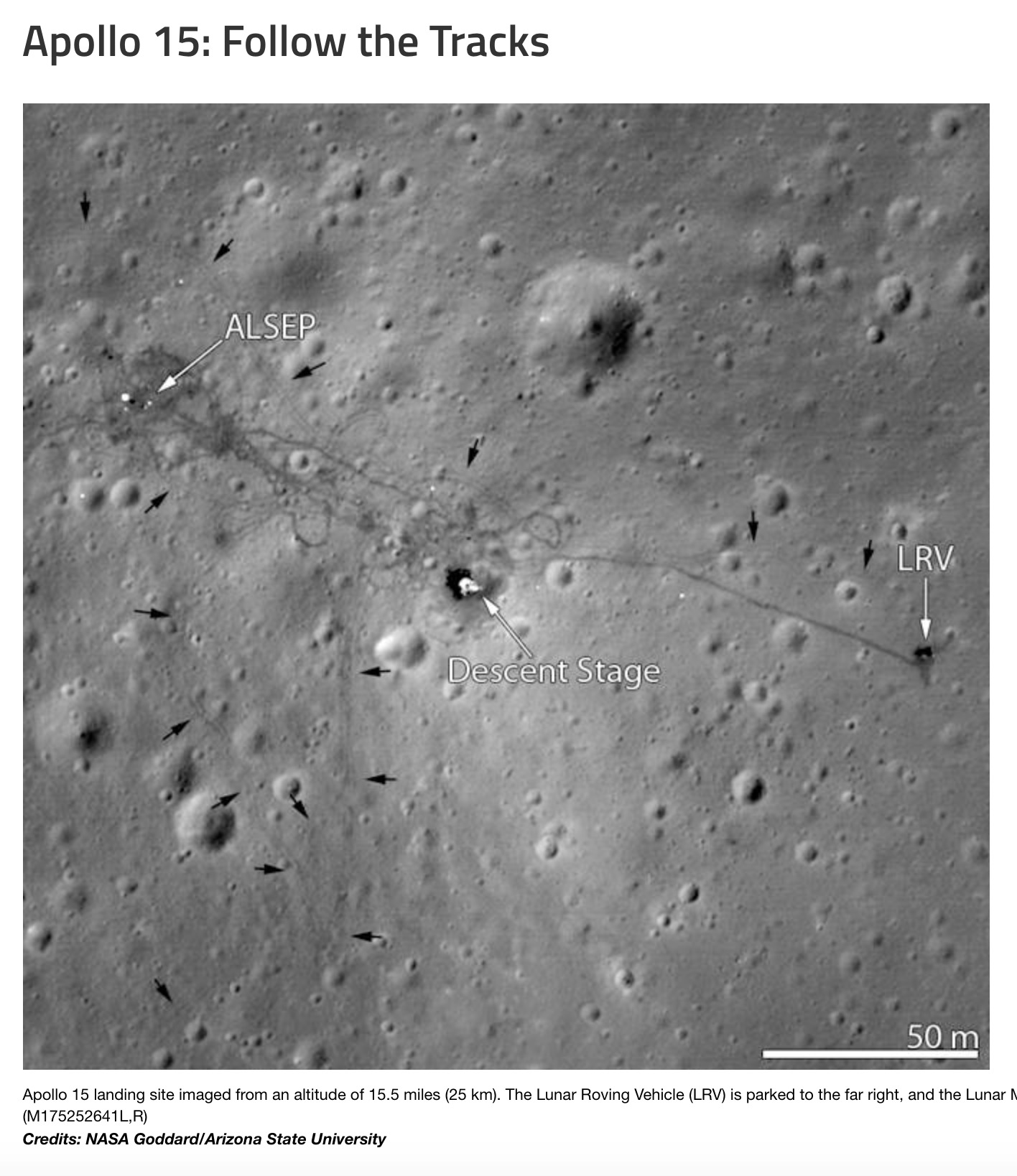
Bouncing Lasers off the Moon:
Lunar Laser Ranging Experiment
https://en.wikipedia.org/wiki/Lunar_Laser_Ranging_experiment
Excerpt (Overview):
The first successful tests were carried out in 1962 when a team from the Massachusetts Institute of Technology succeeded in observing laser pulses reflected from the Moon's surface using a laser with a millisecond pulse length.[2] Similar measurements were obtained later the same year by a Soviet team at the Crimean Astrophysical Observatory using a Q-switched ruby laser.[3] Greater accuracy was achieved following the installation of a retroreflector array on July 21, 1969, by the crew of Apollo 11, and two more retroreflector arrays left by the Apollo 14 and Apollo 15 missions have also contributed to the experiment. Successful lunar laser range measurements to the retroreflectors were first reported[when?] by the 3.1 m telescope at Lick Observatory, Air Force Cambridge Research Laboratories Lunar Ranging Observatory in Arizona, the Pic du Midi Observatory in France, the Tokyo Astronomical Observatory, and McDonald Observatory in Texas.
The uncrewed Soviet Lunokhod 1 and Lunokhod 2 rovers carried smaller arrays. Reflected signals were initially received from Lunokhod 1, but no return signals were detected after 1971 until a team from University of California rediscovered the array in April 2010 using images from NASA's Lunar Reconnaissance Orbiter.[4] Lunokhod 2's array continues to return signals to Earth.[5] The Lunokhod arrays suffer from decreased performance in direct sunlight—a factor considered in reflector placement during the Apollo missions.[6]
The Apollo 15 array is three times the size of the arrays left by the two earlier Apollo missions. Its size made it the target of three-quarters of the sample measurements taken in the first 25 years of the experiment. Improvements in technology since then have resulted in greater use of the smaller arrays, by sites such as the Côte d'Azur Observatory in Nice, France; and the Apache Point Observatory Lunar Laser-ranging Operation (APOLLO) at the Apache Point Observatory in New Mexico.
(Please read this full article at the URL posted above)
-
Bouncing Lasers = First two-way laser ranging to a lunar orbiter:
First two-way laser ranging to a lunar orbiter: infrared observations from the Grasse station to LRO’s retro-reflector array
Abstract:
We present the results of the first series of successful two-way laser ranging experiments from a ground station, the Lunar Laser Ranging (LLR) station in Grasse, France, to a spacecraft at lunar distance, the Lunar Reconnaissance Orbiter (LRO). A 15 × 18 × 5 cm, 650-g array of twelve 32-mm diameter solid corner cubes is mounted on its anti-nadir deck. Ranging to this small retro-reflector array onboard a lunar orbiter from a ground station was a challenge compared to ranging to larger lunar surface retro-reflectors. Grasse measured 67 returns in two 6-min sessions on September 4, 2018. Clear returns were also recorded during two additional sessions on August 23–24, 2019 for which active slewing by LRO was performed to bring the array in view of the station. The measured echos yielded range residuals less than 3 cm (two-way time-of-flight RMS < 180 ps) relative to the reconstructed LRO trajectory. This experiment provides a new method of verifying theories of dust accumulation over decades on the lunar surface. It also showed that the use of similar arrays onboard future lunar landers and orbiters can support LLR lunar science goals, particularly with landing sites near the lunar limbs and poles, which would have better sensitivity to lunar orientation.
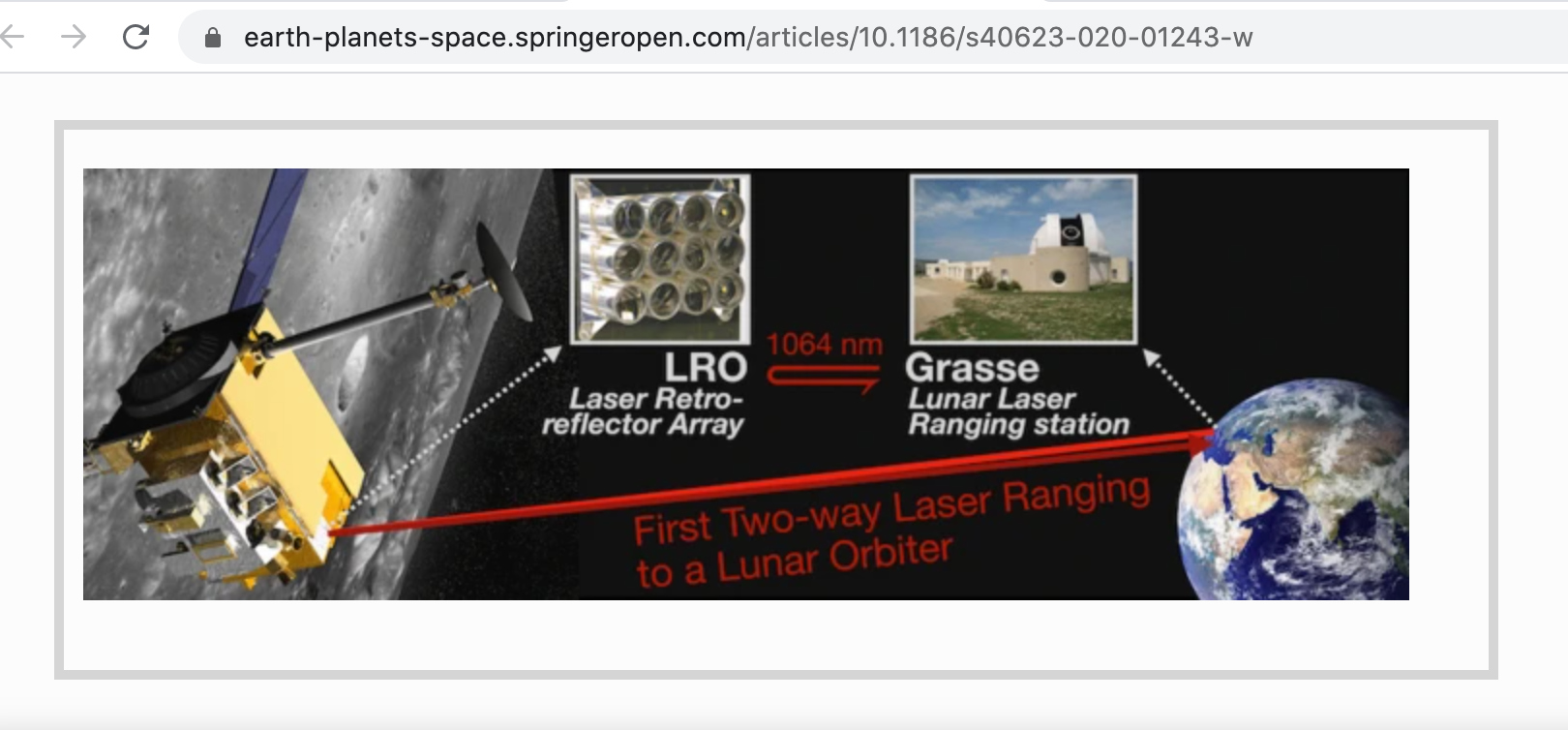
-
China just bounced a laser off reflectors on the Moon placed by NASA's Apollo 15 mission, by Andrew Jones (January 24, 2018) of the gbtimes
(https://gbtimes.com/china-just-bounced-a-laser-off-reflectors-on-the-moon-placed-by-nasas-apollo-15-mission)
Excerpt:
China has successfully used a 1.2-metre telescope laser ranging system to bounce light off a retroreflector placed on the Moon during NASA's Apollo 15 crewed lunar mission.
The Lunar Laser Ranging (LLR) experiment, a national first, was carried out by the applied astronomy group from the Yunnan Observatories, operating under the Chinese Academy of Sciences (CAS).
LLR is used to achieve the highest accuracy measurements of the distance between the Earth and the Moon. Before now, only the US, France and Italy had successfully deployed LLR technology.
According to the group, the distance between the retroreflector in the Hadley–Apennine region of the near side of the Moon and the Yunnan Observatory was 385,823.433 km to 387,119.600 km from 9:25 pm to 10:31 pm Beijing Time on January 22.
The Apollo 15 Lunar Laser Ranging RetroReflector (LRRR) array is the largest of four such working arrays on the surface of the Moon, according to NASA, with a size of 105 x 65 cm. The other active LRRRs are at the Apollo 11 and Apollo 14 landing sites, and on the Soviet Union's Lunokhod 2 rover.
The hardware from Apollo 15 was placed on the Moon by astronaut David Scott on July 31, 1971.
-
YouTube video - China just bounced a laser off reflectors on the Moon placed by NASA's Apollo 15 mission
https://www.youtube.com/watch?v=K8fpZdxrzd4
Independent observations:
Article - https://en.wikipedia.org/wiki/Third-party_evidence_for_Apollo_Moon_landings
Moon landing conspiracies debunked:
Article - Moon landing conspiracy theories aren't true - here's how we know, bbc.co.uk
Article - 10 proofs the Moon Landing was real, debunking conspiracy theories, at earthsky.org
Article - The Deadly Van Allen Belts?
- - -
Update: April 2, 2021
Experience the Apollo 11, 13 and 17 missions in real time.
For those that say these events never happened, listen to the hundreds of hours of space-to-ground audio, see the pictures, video & voice from the surface during the walks, mission details - so please stop your DENIALS since you are just embarrassing yourself.
Apollo in Real Time
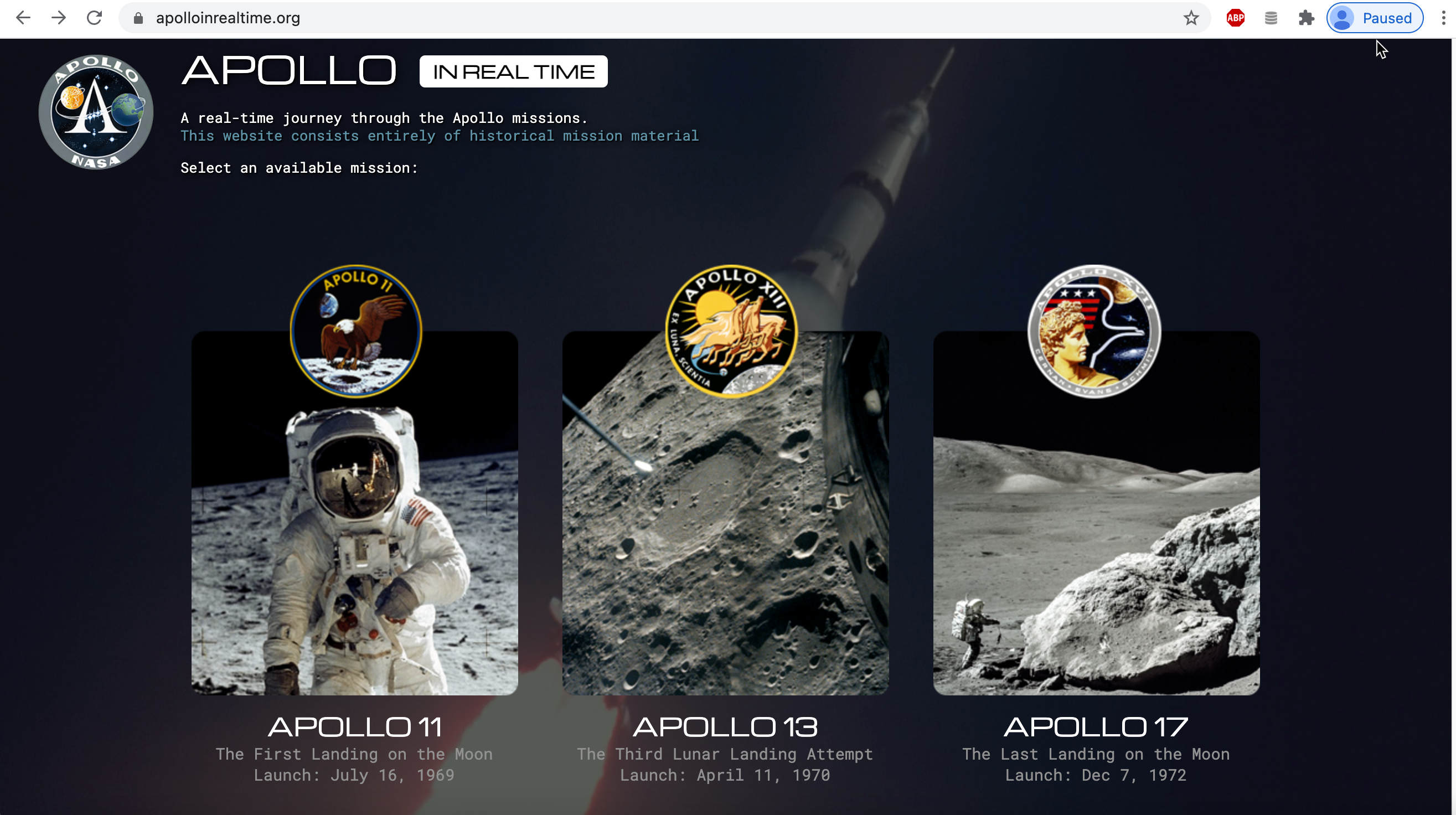
- - -
Apollo 11
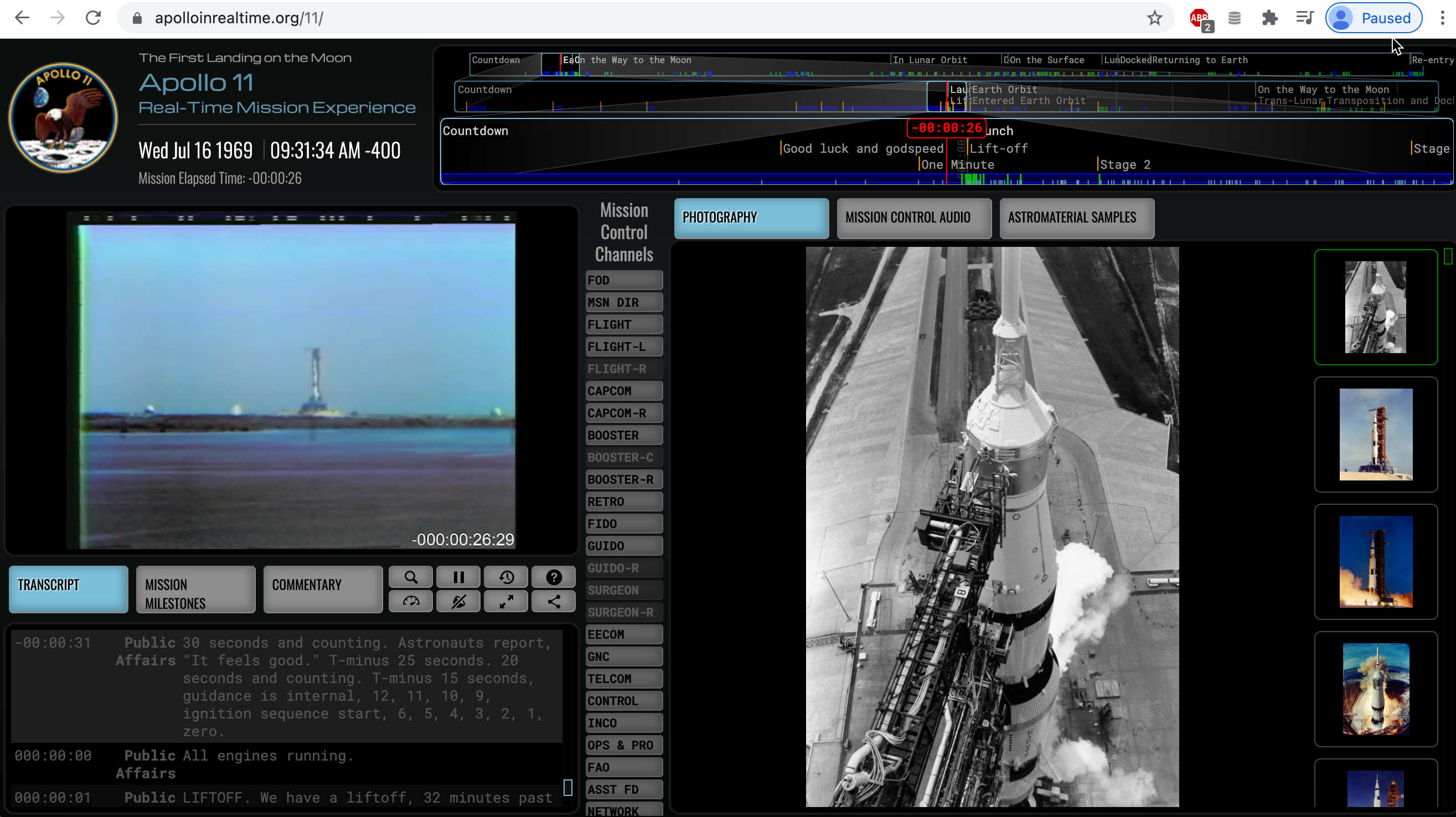
Included real-time elements:
- All mission control film footage
- All TV transmissions and onboard film footage
- 2,000 photographs
- 11,000 hours of Mission Control audio
- 240 hours of space-to-ground audio
- All onboard recorder audio
- 15,000 searchable utterances
- Post-mission commentary
- Astromaterials sample data
- - -
Apollo 13
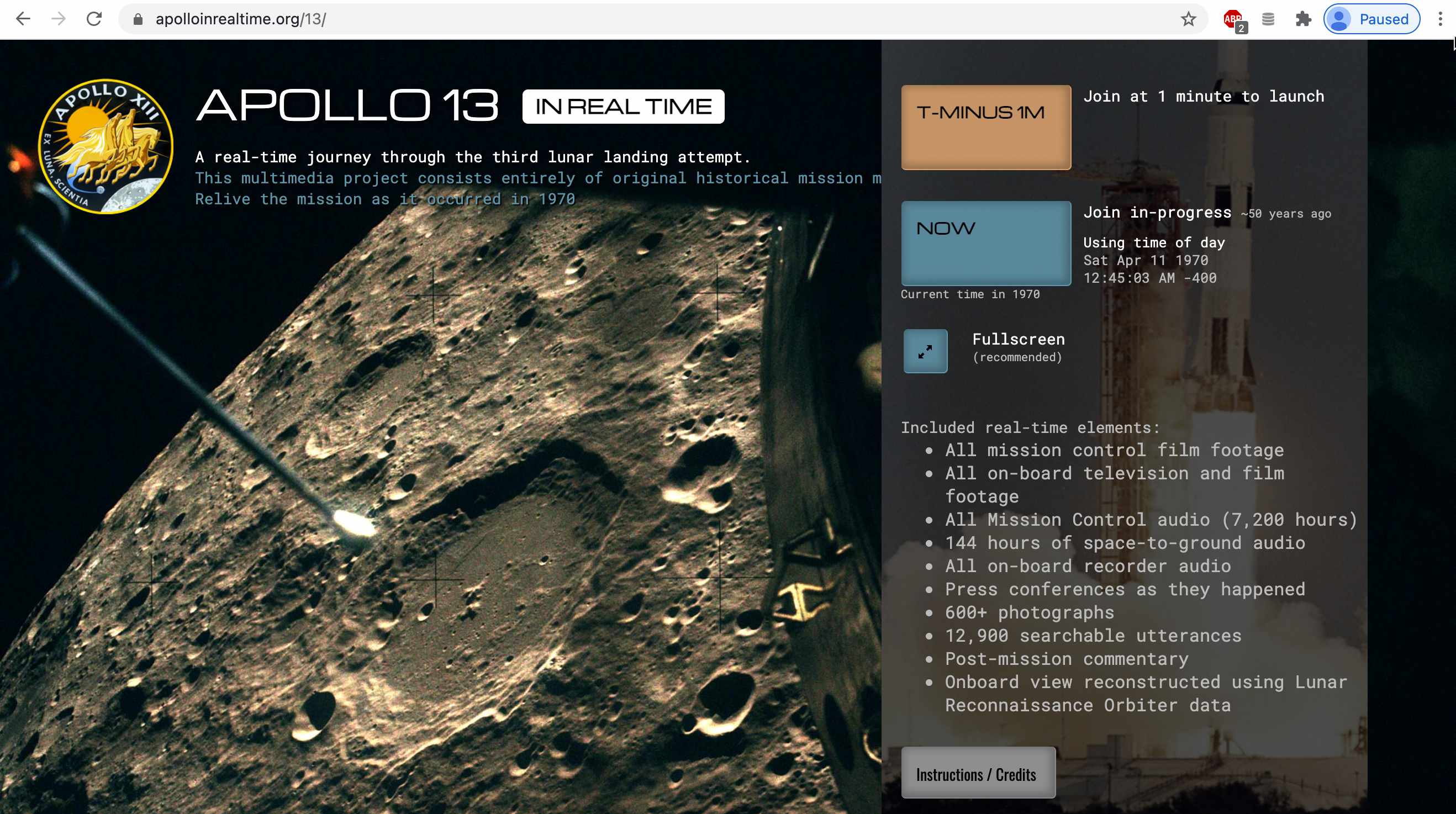
Included real-time elements:
- All mission control film footage
- All on-board television and film footage
- All Mission Control audio (7,200 hours)
- 144 hours of space-to-ground audio
- All on-board recorder audio
- Press conferences as they happened
- 600+ photographs
- 12,900 searchable utterances
- Post-mission commentary
- Onboard view reconstructed using Lunar Reconnaissance Orbiter data
- - -
Apollo 17
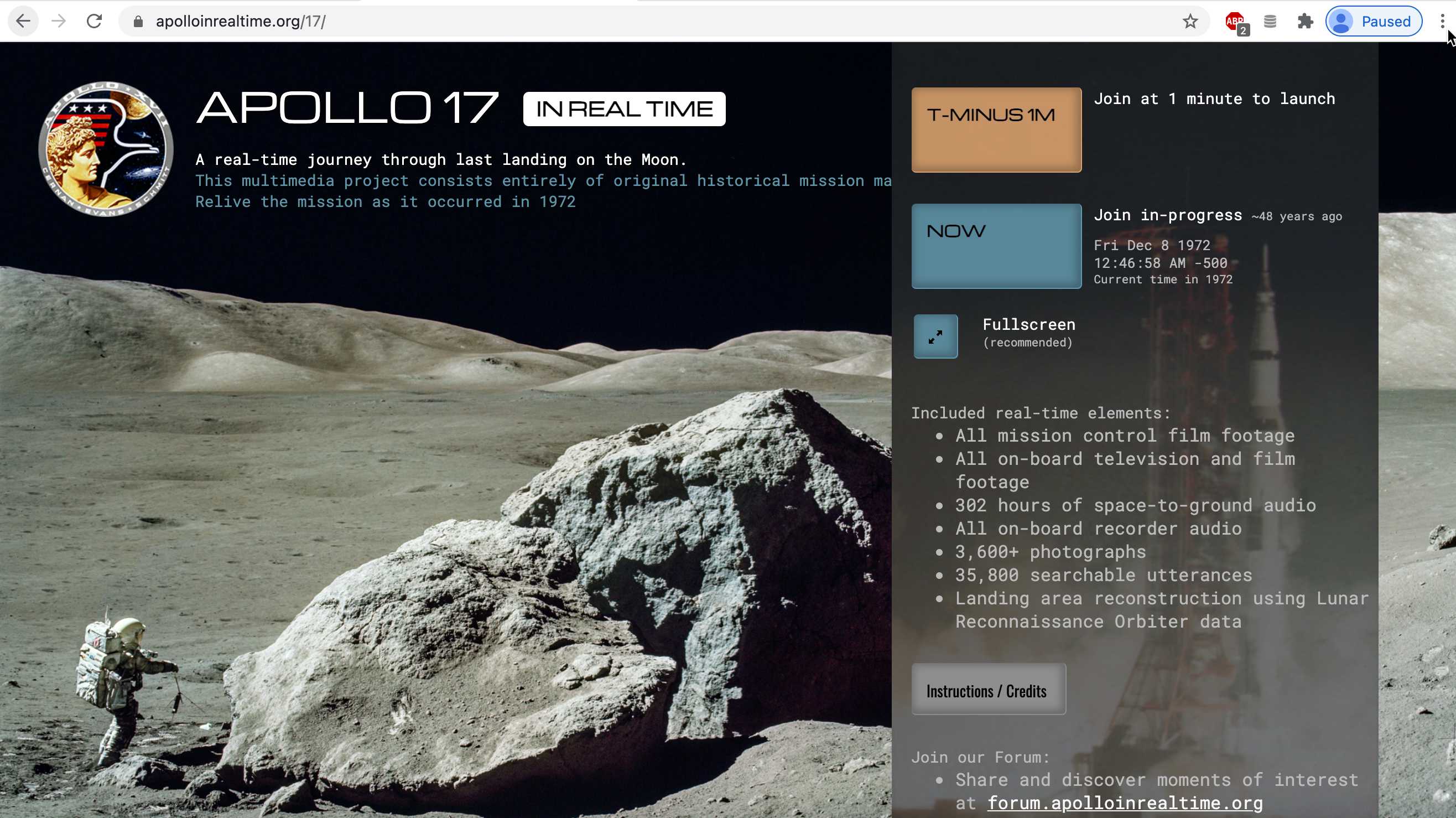
Included real-time elements:
- All mission control film footage
- All on-board television and film footage
- 302 hours of space-to-ground audio
- All on-board recorder audio
- 3,600+ photographs
- 35,800 searchable utterances
- Landing area reconstruction using Lunar Reconnaissance Orbiter data
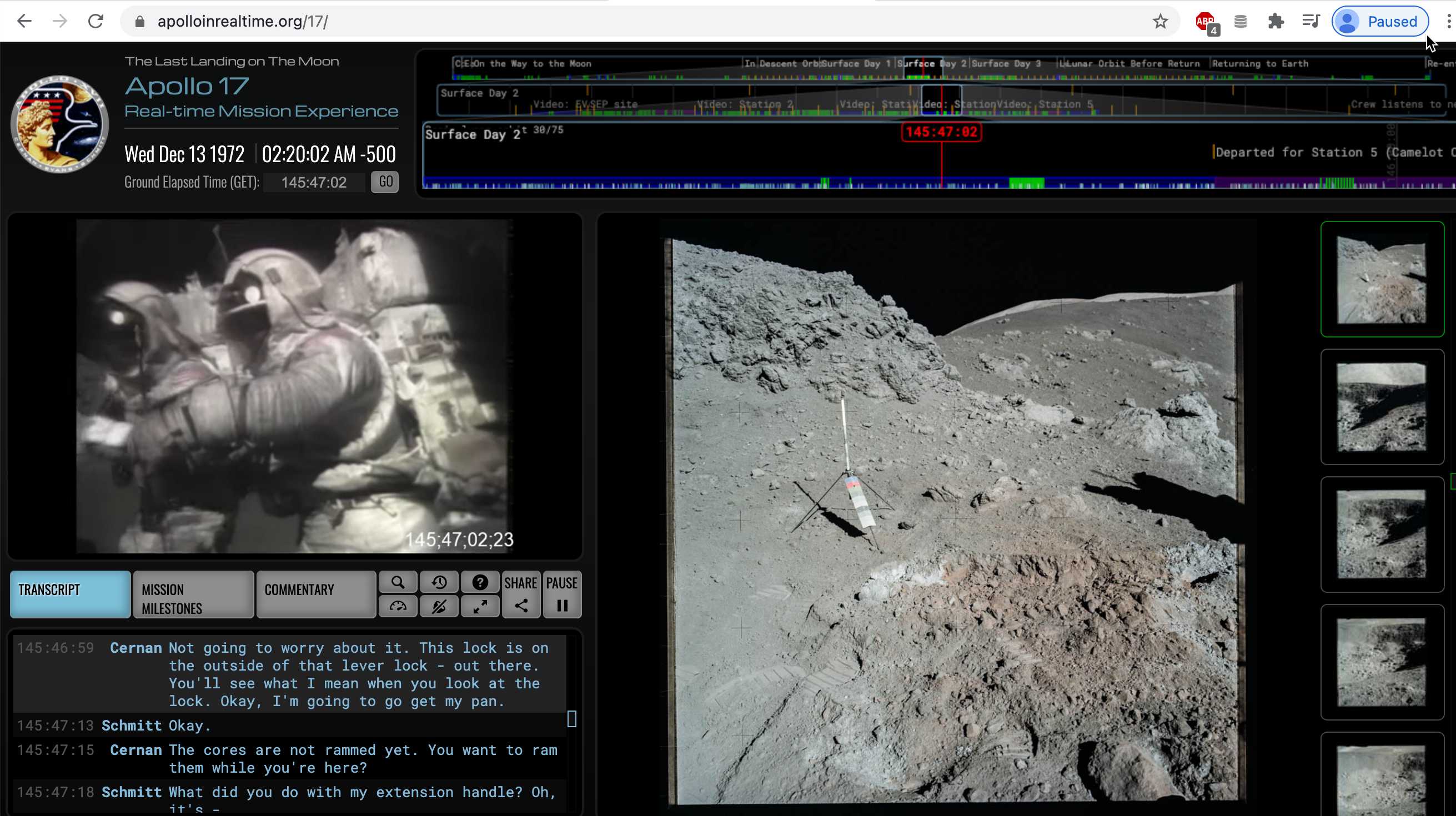
Other info...
Official NASA Apollo photo archives at...
Apollo Lunar Landing Missions:
Apollo 11 - Landed on Moon 20 July 1969, Sea of Tranquility, Returned to Earth 24 July 1969
Apollo 12 - Landed on Moon 19 November 1969, Ocean of Storms, Returned to Earth 24 November 1969
Apollo 14 - Landed on Moon 5 February 1971, Fra Mauro, Returned to Earth 9 February 1971
Apollo 15 - Landed on Moon 30 July 1971, Hadley Rille, Returned to Earth 7 August 1971
Apollo 17 - Landed on Moon 11 December 1972, Taurus-Littrow, Returned to Earth 19 December 1972
Apollo 11 Image Library
http://www.hq.nasa.gov/alsj/a11/images11.html
Apollo 12 Image Library
https://www.hq.nasa.gov/alsj/a12/images12.html
Apollo 14 Image Library
http://www.hq.nasa.gov/alsj/a14/images14.html
Apollo 15 Map and Image Library
https://www.hq.nasa.gov/alsj/a15/images15.html
Apollo 16 Map and Image Library
http://www.hq.nasa.gov/alsj/a16/images16.html
Apollo 17 Image Library
http://history.nasa.gov/alsj/a17/images17.html
- - -
Published on – September 2, 2020
Discussion at - https://www.youtube.com/channel/UC7ipUKERU0tzYFxALJBli4A/discussion
Our home page all articles - http://flatearthlunacy.com
kind regards, JonahTheScientist



